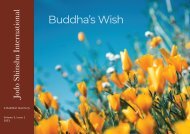You also want an ePaper? Increase the reach of your titles
YUMPU automatically turns print PDFs into web optimized ePapers that Google loves.
FEATURED ARTICLE - NĀGĀRJUNA AND THE EASY PATH TO AWAKENING<br />
The analysis of the reality<br />
of things and beings<br />
around us, as well as of our<br />
own person, leads to the<br />
realisation that nothing and<br />
no one exists by itself.<br />
major rules for determining textual authority, which had<br />
already been developed before him. The first says that one<br />
should refer to the texts of the scriptures rather than to<br />
the authority of an individual, even the Buddha himself.<br />
The second is to rely on meaning rather than on the letter.<br />
The third enjoins reliance on wisdom, born from practice,<br />
rather than mere intellectual and discursive knowledge.<br />
Finally, the fourth advocates relying on the sūtras of<br />
definitive meaning rather than the others. It was these<br />
rules that enabled Buddhism to develop an extremely<br />
diverse literature of commentaries. Shinran will certainly<br />
make use of them.<br />
Finally, there is one aspect of Nāgārjuna that cannot<br />
be ignored: his philosophical dimension, which goes far<br />
beyond the framework of Buddhism and makes him one<br />
of the great thinkers of Humanity. In this respect, he is<br />
considered the founder of Mādhyamika (“Medialism”),<br />
one of the two main philosophical currents of the Greater<br />
Vehicle, the second being that of Idealism (Yogācāra). In<br />
this field, Nāgārjuna’s major work is certainly his famous<br />
Fundamental Stanzas of the Middle (Mūla madhyamaka kārikā).<br />
The whole of Buddhism can indeed be considered<br />
as a “middle way”, following the example of Śākyamuni<br />
himself, who, after having experienced the extreme of<br />
pleasures during his youth as a prince, embarked on the<br />
extreme of asceticism before finally renouncing it in order<br />
to follow a balanced path between these two and become<br />
a Buddha. However, Nāgārjuna’s Middle Way is more<br />
philosophical. It consists in keeping an equal distance<br />
between the real existence of things and beings, and their<br />
fundamental non-existence. The analysis of the reality of<br />
things and beings around us, as well as of our own person,<br />
leads to the realisation that nothing and no one exists<br />
by itself. Everything that exists is in fact a provisional<br />
assembly of multiple elements joined together by various<br />
causes and conditions, which disintegrate when the causes<br />
that brought them together are exhausted. Thus, at the<br />
moment of death, we see the decomposition of the physical<br />
body by the disintegration of the physical elements that<br />
constitute a person. The same is true of the mental<br />
elements that make up the spirit, none of which can be<br />
isolated in what would be called “a soul”. So that if beings<br />
exist, it is only to a certain extent, that which constitutes<br />
“relative truth”. But since they do not exist at all by<br />
themselves, they do not exist in “absolute truth”. In short,<br />
everything is devoid or empty of any self-substance, stable<br />
and permanent. This is universal emptiness (śūnyatā),<br />
which is at the heart of the Mādhyamika and which will<br />
be one of the favourite topics of the Chinese Chan or<br />
Japanese Zen traditions.<br />
Shinran’s teaching is intended to be practical, so<br />
that it does not offer long philosophical developments.<br />
Nevertheless, all his thought is radically marked by<br />
Mādhyamika, which deeply imbues the doctrine of the<br />
Tendai school in which he was trained for twenty years. In<br />
his Poem of the nembutsu of True Faith (Shōshinge), which is the<br />
heart of his work, Shinran relates a prediction made by<br />
the Buddha:<br />
The Tathāgata Śākyamuni, on the Mount of Laṅkā,<br />
Announced to the community: “In southern India,<br />
The great hero Nāgārjuna will appear in this world<br />
10










